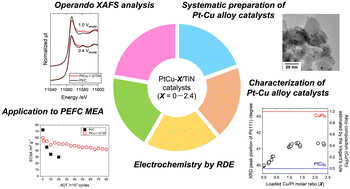Local structures and robust oxygen reduction performances of TiN-supported bimetallic Pt–Cu electrocatalysts for fuel cells†
Abstract
The local structures and oxygen reduction reaction (ORR) performances of Pt–Cu fuel-cell electrocatalysts on robust TiN nanoparticles were investigated. The structures of the PtCu/TiN catalysts were fully characterized by XRF, XRD, TEM, STEM-EDS, XAFS, and XPS, which revealed that loaded Cu was partially alloyed with Pt and fine Pt–Cu alloy nanoparticles (2–3 nm) were formed on TiN. The alloying of Cu to Pt was saturated at the Cu/Pt molar ratio (X) of 1.0 and the fraction of Cu in the alloy structure was estimated to be 40%. The ORR activity was found to be affected by the formation of the Pt–Cu alloy structure, and the electrocatalytic activity enhanced with increasing X. Notably, the best ORR performance was obtained at X = 1 and further Cu loading produced cationic Cu2+ species, which did not improve the ORR activity. We also evaluated the performance of the PtCu/TiN catalyst (X = 1) on a PEFC MEA, which showed 1.5 times higher mass-specific power density, compared to an MEA with a commercial Pt/C catalyst, and significant durability (70% of ECSA after 80 000 cycles of the typical accelerated degradation test of the PEFC).



 Please wait while we load your content...
Please wait while we load your content...